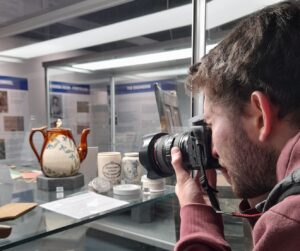Working and Learning with a Kickstart Employee at the Museum of Lead Mining

The project
MGS had already provided grant funding for the Museum of Lead Mining, Wanlockhead, to develop the Audience Engagement Strategy and to employ a fixed term Audience Engagement Coordinator. The museum saw employing a young person through the Kickstart scheme as an opportunity to support the developing Audience Engagement Strategy. The aim of this new post was to develop the museum’s social media presence and support the career development of the incumbent.
Calum joined our team bringing graphic design skills with him. It was a hybrid post working remotely and on-site. As well as bringing skills with him he further developed practical skills related to his undergraduate studies.
"Kickstart and the Museum of Lead Mining enabled me to use my creative skills in the heritage sector to benefit not only the museum, but also myself."
Calum, Kickstart employee, Museum of Lead Mining
Challenges and successes
As an employer they were:
- We thought it would be a challenge to recruit because of our rural position and limited public transport. We were proved wrong!
- New challenges included ensuring that Calum’s remote workplace met Healthy and Safety regulations.
- Working with Calum made it clear that the impact of Covid on undergraduate training is poorly recognised. Nothing to do with rigorous academic standards, but to do with the experience gained by working with different people, getting out into the workplace and developing networks that underpin future career steps.
The challenges and successes for Calum were:
- Time management was a challenge at first. I split my 25 hours/week over 5 days. This was a successful timetable with one day at the museum providing me with enough work to keep me busy for the week.
- I was encouraged to take lots of photographs to post on social media and so I further developed my photography skills, learning how to take photographs of museum guests and how to photograph museum objects.
- Disappointment that an online shop was less useful than expected. However, I learned a lot about web design while creating it.
- The challenge of taking photos inside the mine due to the low light levels. I learned a lot about camera settings and techniques for difficult conditions.
The impact it has made
On the museum:
- Transformation of the social media program with an increased following and engaging stories.
- Integration of Facebook with our Twitter feed and its increasing following.
- With support from the Business School at Glasgow University’s research program we launched and are evaluating our Instagram presence.
- Production of high-quality photographs to be used in the new website.
- Satisfaction of watching Calum grow in confidence and put his learned skills into practice. A spark has been ignited to pursue learning and skill development within the heritage sector.
The impact on Calum:
- Developing the museum’s social media presence built on my undergraduate skills.
- It stimulated my interest in history and the heritage sector. Working at the museum has caused me to fall in love with museums. The fascinating information held in the archive amazes me. The passion that the staff has for it is infectious.
- Regular meetings with the Museum Team Leader provided constructive feedback and gave direction to my work and development.
- Meeting the MGS Careers advisor once a month has been incredibly useful. He always seemed eager to help me improve my CV and interview skills. I now feel confident in securing a job that I will enjoy and benefit from.
Lessons learned
As an organisation we learnt that there is an untapped resource in the community and all efforts should be made to recruit and train young adults. They will seize any opportunity and flourish with encouragement. Smaller museums can offer employment for development, but benefit from the support of the Workforce Development team at MGS. Lastly, hybrid working can work, but the employer must take responsibility to ensure the employee is in a safe, remote working environment.
As an employee I found that working in the heritage sector leads to continuous learning about the museum and local history which helps to better inform the public. I also learnt that hybrid working can be highly effective when you manage your time sensibly and that there is a need for continuous development of creative skills, such as photography in poor conditions like the mine. Also to take responsibility for your own health and safety when working remotely e.g., taking regular breaks.
Guidance
As an employer:
- It is possible to recruit effectively in remote sites
- Young adults need encouragement to develop their inherent abilities.
- Be responsible for employee’s safety on and off-site.
As an employee:
- Create a clear timetable to work to, including breaks.
- Make your skills known to the employer or you may miss opportunities by being modest. I declared that I was good at photography and the work that followed benefited both the museum and my portfolio.
- Always ask questions and make sure you are an asset to the company.